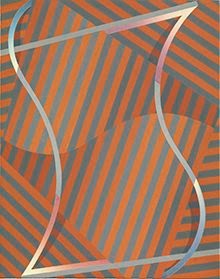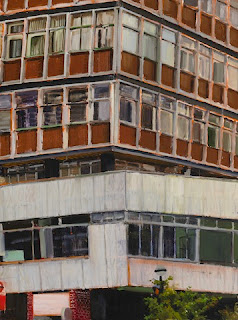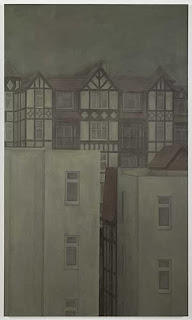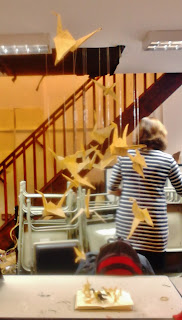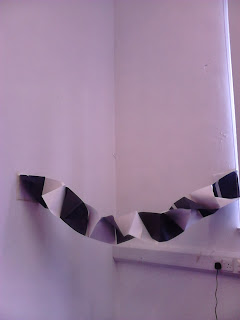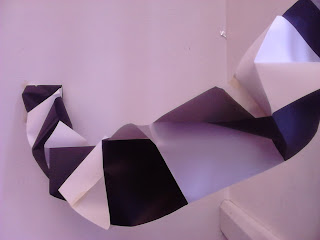Set in the midst of war and
famine in ancient Rome, the play begins in the streets of ancient Rome where
plebeians fought for more grain and a democratic society. In response to the riots, the wealthy patricians
decide to appoint tribunes to represent the lower classes, including war hero
Caius Martius, who is granted the name ‘Coriolanus’ in recognition of his great
deeds in the siege of Corioli and defeating the enemy Volscians. However, in order to become consul, Coriolanus must
plead for the votes of the plebeians. Overcome by his pride and arrogance,
Coriolanus fails to play the role of the diplomat and is rejected by the
plebeians after some persuasion from two clever and manipulative tribunes,
Brutus and Sicinius, or Sicinia, as Rourke’s Sicinius is female. Driven to fury,
Coriolanus speaks ill of the very idea of democracy and is declared a traitor to
the Roman state and exiled.
Visual semiotics is essential to
the success and coherence of any performance, achieved mainly by effective set
design and costumes, which support and enhance the narrative, and Josie
Rourke’s production of Coriolanus at the Donmar Warehouse is no different.
These components are crucial in the audience’s understanding of the themes,
mood and context of the performance, both geographical and historical, the
latter of which is made slightly ambiguous in Rourke’s production as she chooses
to emphasise the tragedy of Coriolanus, the fallen soldier, and the political
issues explored in the play. Set designer Lucy Osbourne uses the intimate space
of the Donmar Warehouse with great ingenuity to support the ideas and narrative
that Rourke focuses on.
Osbourne creates a set that is
stark and bare, with only a high brick wall, a ladder and twelve chairs. The
minimalist approach to the set allows the audience to focus solely on the
emotions of the characters and their story. Removing the barriers that
historical context may create, the audience is better able to sympathise with
the characters and see them as human beings, even applying the themes of the
play to their own lives, rather than viewing them as relics from a long
forgotten past thus creating a sense of detachment.
 |
The company
of Coriolanus, main stage. Donmar Warehouse 2013.
|
In addition to the props on stage,
an unusual, diamond shape is seen on the stage floor, which young Coriolanus
paints over in blood red paint, marking the area where most of the action takes
place. Perhaps this is a subtle technique used by Osbourne which serves as a
foreboding of the blood shed that is to come. It can be argued that the
arrangement of the row of chairs present on stage throughout the play could be
likened to chairs in parliament, as the consul plays a similar role. The
political narrative of Rome as a nation suffering from war and striving towards
a new, democratic state is further reflected in the design of the chairs;
uniform, bare and unadorned, as well as matching the production’s overall
aesthetic.
Similar to Osbourne, Lucy
McKenzie, a young Scottish artist, uses interiors and objects as a way of
exploring narratives. Inspired by Greil Marcus’s book ‘In the Fascist Bathroom’
on post punk, McKenzie decided to quite literally explore what the interior
design of a space may look like in accordance to particular political and
ideological inclinations. In her paintings called ‘Quodlibet’ XII,
XXII and XX, subtitled Objectivism, Nazism, Fascism, respectively, McKenzie
depicts a cork pinboard which functions as a collage on which she assembles
copies of paint samples, various kinds of marble and architectural drawings. In
each of the three paintings, the artist creates slightly different variations
of one aesthetic style in accordance to a particular ideological narrative.
In ‘Nazism’, the colour palette
on both the marble and paint samples is similar to that which is associated
with neoclassical architecture, most popular amongst the members of the third
Reich and Hitler himself. The plans for both the interiors and the architecture
showed an emphasis on minimal decorations and an emphasis on straight lines which
was typical of neoclassicism. Finally, the book cover titled “Das Behagliche
Heim,” which describes “how one recognizes a National Socialist by his home”,
neatly ties together a representation of Nazism through design.
 |
Lucy
Mckenzie’s Quodlibet ‘Nazism’ and ‘Objectivism’
|
Equally, in ‘Objectivism’,
McKenzie not only provides the viewers with modernist architectural drawings
but also presents us with disparate symbols. For example, the painting depicts
the cover of an Ayn Rand book, the founder of the objectivist philosophy, and a
photograph of Tarama de Lempicka along with some of her works, which can be
found on the covers of several editions of Rand’s novels. The colours; deep
reds, greens and greys, are characteristic of the modernist colour palette and
can be seen in the marble samples as well as Lempicka’s paintings. By compiling
these subjects in her painting McKenzie creates a narrative through design that
is recognisable and understandable to the audience.
Osbourne uses colours as symbols
of power and to support the development of characters. For example, the
costumes and leather accessories, in warm, muted tones of greys, reds and browns,
compliment the dismal and almost apocalyptic mood of the play as well as
exuding a sense of unstated power. Some characters, such as Aufidius, and even
Brutus and Sicinia, are often seen wearing dark blues and purples which are
colours associated with power or high class in ancient Rome. Whereas these
colours are fitting for Aufidius, general of the Volscian army, it is interesting
that Brutus and Sicinia, despite being plebeians, are seen wearing such
colours. Perhaps Osbourne uses this as a subtle hint to show that both have
reached a higher state due to their influence and manipulation of the masses in
the condemnation of Coriolanus.
 |
Coriolanus (top), Aufidius (middle), Brutus (bottom)
|
Furthermore, the imagery
surrounding Coriolanus’ costume shows his decline in Roman society and supports
the possible interpretation of his character as a martyr, a tragic hero. Seen
in earlier as a noble, Roman general, ready for battle with in his red, leather
armour, Coriolanus’ costume changes as the play progresses -his crown looks as
though it is made of thorns and his senator’s garments resemble the robes of
Christ.
 |
Coriolanus and Aufidius. Donmar Warehouse. 2013
|
However, during the siege of
Corioli, video designer Andrzej Goulding transforms the bricked wall- an
explosion of flashing fireworks is projected on it; with falling rubble, dark
lighting and sound designer Emma Laxton’s loud, electronic music, an atmosphere
of chaos is created which appropriate for the war going on somewhere beyond the
stage, or perhaps above it, as suggested by Ismene Brown from The Art
Desk. Brown comments: ‘The war is heard,
not seen within the high black and blood-red brick walls, somewhere up above a
high ladder into, perhaps, street level from this bunker’(Brown 2013). This
poses an interesting question as to whether Rourke and Osbourne were commenting
on the tendency of politics and manipulation, as it is the consul who decides
the fate of Coriolanus from hero, to enemy and exiled, to take place ‘behind
the scenes’, a safe distance away from the violence and death their decisions
may cause.
 |
| Coriolanus. Donmar Warehouse 2013 |
The stage is transformed once
again in what was arguably the most compelling, intimate and revealing scene,
not originally in the play, in which an exhausted Coriolanus stands alone,
centre stage, washing away the blood from his battle wounds. Lighting designer
Mark Henderson darkens the entire stage, save for the inescapable, ferocious
white light that shines upon him as water surges down on from high above,
turning red as it mixes inextricably with the blood from his injuries. David
Benedict of Variety describes it as ‘a magnificent image in its own right’, as
the water is ‘spraying into the dark like sparks off steel’ (Benedict
2013). By removing all other aspects of the set from view, Henderson emphasises
Coriolanus’ isolation, showing a physical and emotional vulnerability to an otherwise
strong, arrogant and unyielding protagonist, thus imposing the idea of him as a
tragic hero.
It is only with the aid of set,
costume, sound and lighting design that such powerful images can be conjured on
stage, convey to the audience ideas and emotions that words don’t always
succeed in doing so. Design helps to build a visual language that transcends
words, not only supporting the action on stage but creating a narrative of its
own, creating tension in a visual form and becoming a living character in
itself.
Bibliography
Benedict, D. 2013. London Theatre
Review: ‘Coriolanus’ Starring Tom Hiddleston. [online] 17th December. Available
at:
http://variety.com/2013/legit/reviews/london-theater-review-coriolanus-starring-tom-hiddleston-1200969320/
[Accessed: 31 Dec 2013].
Bilgehan Özpek, B. 2006. Ayn Rand, Objectivism and Architecture.
MA. The Graduate School of Social Sciences of Middle East Technical University.
Billingdon, M. 2013. Coriolanus
Review. The Guardian, 18th
December.
Bracewell, M. 2011. Adventures
Close to Home. Mousse Magazine,
Iss. 29.
Brecknell, L. 2013. Review: Coriolanus. [online] Available
at:
http://theyorker.co.uk/arts/performing-arts/off-campus/14543-review-coriolanus/
[Accessed: 26 Dec 2013].
Brown, I. 2013. Coriolanus, Donmar Warehouse | Theatre
reviews, news & interviews | The Arts Desk. [online] Available at:
http://www.theartsdesk.com/theatre/coriolanus-donmar-warehouse/ [Accessed: 27
Dec 2013].
Colquhoun, A. 2002. Modern architecture. Oxford: Oxford
University Press.
Coriolanus, Donmar Warehouse,
review. 2013. [online] 18th December. Available at:
http://www.telegraph.co.uk/culture/theatre/theatre-reviews/10524062/Coriolanus-Donmar-Warehouse-review.html
[Accessed: 24 Dec 2013].
Donmarwarehouse.com. 2013. Coriolanus - Donmar Warehouse.
[online] Available at:
http://www.donmarwarehouse.com/whats-on/donmar-warehouse/2013/coriolanus/
[Accessed: 20 Dec 2013].
Feisner, E. A. 2000. Colour. London: Laurence King.
Kueber, P. 2008. 1950s and 60s paint colors -- from
Sears' classic Harmony House collection - Retro Renovation. [online] Available
at:
http://retrorenovation.com/2008/01/02/1950s-and-60s-paint-colors-from-sears-classic-harmony-house-collection/
[Accessed: 11 Jan 2014].
Leaver-Yap, I. 2013. Afterall • Journal • Lucy McKenzie:
Manners. [online] Available at:
http://www.afterall.org/journal/issue.34/lucy-mckenzie-manners [Accessed: 28
Dec 2013].
Leavitt, D. 2009. Mid Century Modern Colours. [online]
Available at: http://www.modative.com/modern-architects-blog/bid/17263/Mid-Century-Modern-Colors
[Accessed: 11 Jan 2014].
Llewellyn-Jones, L. 2001. The Use of Set and Costume Design in
Modern Production of Ancient Greek Dramas. The Open University.
Rosenfeld, G. D. 2000. Munich and memory. Berkeley:
University of California Press.
Sitemaker.umich.edu. 2014. Art Under Fascism: Architecture.
[online] Available at: http://sitemaker.umich.edu/artunderfascism/architecture
[Accessed: 29 Dec 2013].
Squidoo. 2014. Traditional Neoclassical Interior
Design and Home Decor. [online] Available at:
http://---chazz.squidoo.com/neoclassical-interior-design-and-home-decor
[Accessed: 29 Dec 2013].
Vesters, C. 2012. Lucy McKenzie’s “50 Shades” | Art
Agenda. [online] Available at:
http://art-agenda.com/reviews/lucy-mckenzie%E2%80%99s-50-shades/ [Accessed: 24
Dec 2013].




